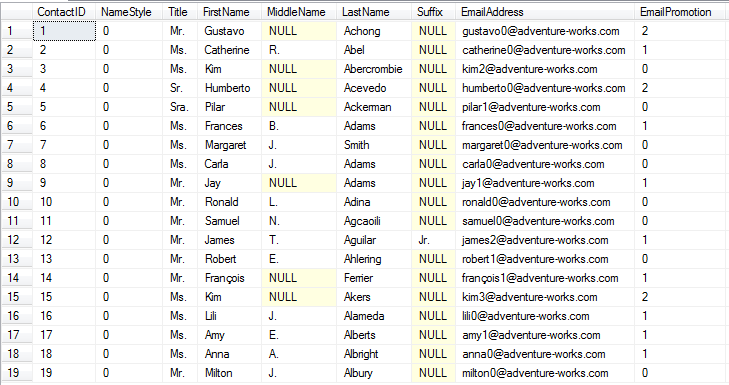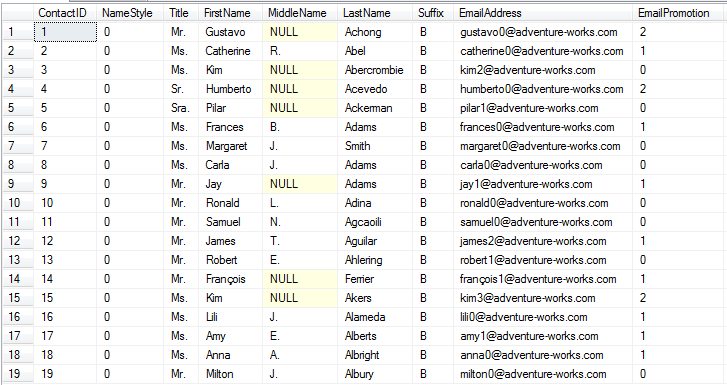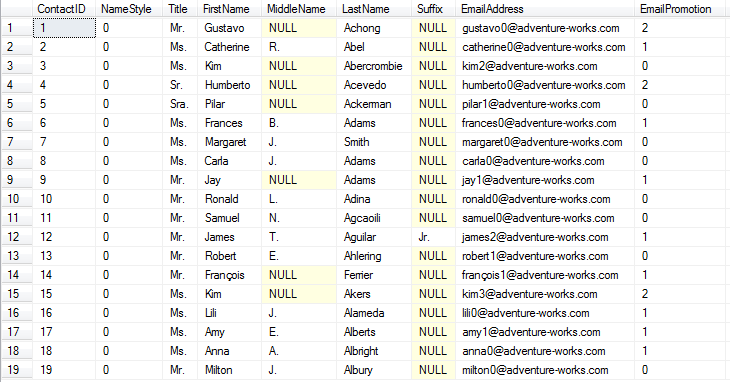SELECT * FROM Person.Contact WHERE ContactID < 20
 Let's say another user runs the below query in a transaction. The query completes and updates the records, but it is not yet committed to the database so the records are locked.
Let's say another user runs the below query in a transaction. The query completes and updates the records, but it is not yet committed to the database so the records are locked.
-- run in query window 1 BEGIN TRAN UPDATE Person.Contact SET Suffix = 'B' WHERE ContactID < 20 -- ROLLBACK or COMMIT
-- run in query window 2
SELECT * FROM Person.Contact WHERE ContactID < 20
If I run sp_who2 I can see that the SELECT statement is being blocked. I will need to either cancel this query or COMMIT or ROLLBACK the query in window one for this to complete. For this example I am going to cancel the SELECT query.
 To get around the locked records, I can use the NOLOCK hint as shown below and the query will complete even though the query in window 1 is still running and has not been committed or rolled back.
To get around the locked records, I can use the NOLOCK hint as shown below and the query will complete even though the query in window 1 is still running and has not been committed or rolled back.
-- run in query window 2
SELECT * FROM Person.Contact WITH (NOLOCK) WHERE ContactID < 20
If you notice below the Suffix column now has "B" for all records. This is because the UPDATE in window 1 updated these records. Even though that transaction has not been committed, since we are using the NOLOCK hint SQL Server ignores the locks and returns the data. If the UPDATE is rolled back the data will revert back to what it looked like before, so this is considered a Dirty Read because this data may or may not exist depending on the final outcome in query window 1.
 If I rollback the UPDATE using the ROLLBACK command and rerun the SELECT query we can see the Suffix is back to what it looked like before.
If I rollback the UPDATE using the ROLLBACK command and rerun the SELECT query we can see the Suffix is back to what it looked like before.
-- run in query window 1
ROLLBACK
-- run in query window 2
SELECT * FROM Person.Contact WITH (NOLOCK) WHERE ContactID < 20
-- or
SELECT * FROM Person.Contact WHERE ContactID < 20
 So the issue with using the NOLOCK hint is that there is the possibility of reading data that has been changed, but not yet committed to the database. If you are running reports and do not care if the data might be off then this is not an issue, but if you are creating transactions where the data needs to be in a consistent state you can see how the NOLOCK hint could return false data.
So the issue with using the NOLOCK hint is that there is the possibility of reading data that has been changed, but not yet committed to the database. If you are running reports and do not care if the data might be off then this is not an issue, but if you are creating transactions where the data needs to be in a consistent state you can see how the NOLOCK hint could return false data.